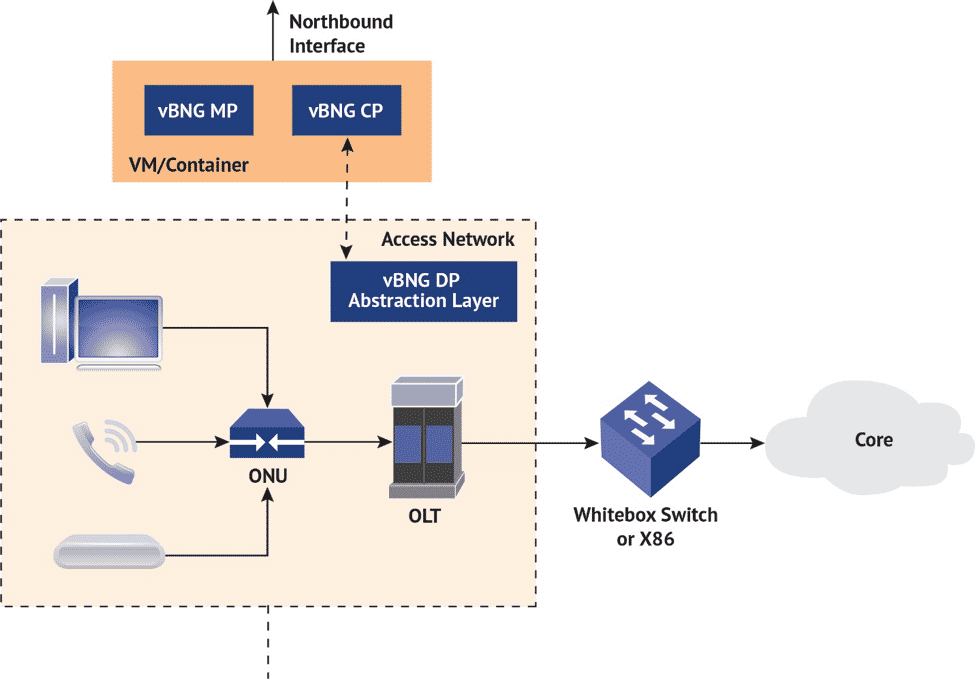What is a BNG?
A Broadband Network Gateway (BNG) is a special type of network router which aggregates subscriber session traffic from access/regional networks into the core network, performing the following tasks for subscribers in addition to routing functions:
- Subscriber session management tasks including subscriber authentication, subscriber session monitoring and session termination.
- Apply different policies to subscriber traffic such as rate limiting, traffic shaping, QoS and security enforcement.
- Relay subscriber traffic to corresponding Service Provider networks using tunneling protocols such as L2TP to support reseller business scenarios.
BNG in the Age of Disaggregation and Cloud-Native Datacenters
Communications Service Providers (CSPs) face pressure to reduce capital expenditure (CAPEX) and operating expenses (OPEX). In addition, the CSPs are searching for methods to scale up their networks quickly to respond to rapid traffic demand increases. Disaggregation is a way to reduce CAPEX by separating hardware from software so they can be selected and purchased independently. The hardware can be inexpensive white boxes rather than proprietary systems.
In traditional approaches, the scaling-up or down of a CSP’s network or the introduction of a new service is difficult and takes a lot of manual configuration. Disaggregation enables CSPs to reduce OPEX by operating and scaling their networks using cloud-native containers and orchestrators. That is why there is demand for BNGs to be disaggregated in a cloud native way where the Control Plane (CP) and Management Plane (MP) of the BNG will be decoupled from the hardware and run in containers or a Virtual Machine on servers in a datacenter. The BNG CP and MP can control and manage white-box routers to perform BNG Data Plane (DP) functionality. This virtualization of the BNG management and control planes is known as a virtual BNG (vBNG) (see Figure 1). The data plane of the vBNG can be offloaded to components that are located closer to subscribers, such as the OLT, to utilize the available capacity of those elements and reduce the overall CAPEX (see Figure 1). In additon, the hardware component can be a white box rather than an expensive proprietary system.

Figure 1: Control plane and management plane of a vBNG are virtualized. Data plane of a vBNG is offloaded to a white-box switch or an access network node, such as an OLT.
Recently the Broadband Forum (BBF) has been working on the specification for a Disaggregated BNG (DBNG) where the control and management plane has been separated from data plane (WT-459). In 3GPP the disaggregation between the control plane and the data plane (called CUPS – Control and User Plane Separation) has been implemented using the Packet Forwarding Control Protocol (PFCP). PFCP is used by the control plane to program the data plane of 3GPP EPC nodes such as the Serving Gateway (SGW), the Packet Gateway (PGW) and the Traffic Detection Function (TDF). BBF is extending PFCP to implement CUPS for DBNG. We also need to mention that the industry generally regards a Disaggregated BNG as a vBNG if its control plane is virtualized while BBF considers DBNG as vBNG if both control plane and data plane are virtualized (see BBF TR-384: Cloud Central Office Reference Architectural Framework).
In conclusion, vBNG development requires expertise and experience in L2/L3/MPLS control planes, management plane and data plane functions. It also requires expertise in the virtualization of control plane and data plane in micro-service architecture running in cloud-native environment. IP Infusion has been building its technical knowledge and experience in these areas and is committed to helping customers develop vBNG products.

